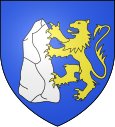Vitrolles-en-Lubéron
| Vitrolles-en-Lubéron | ||
|---|---|---|

|
|
|
| region | Provence-Alpes-Cote d'Azur | |
| Department | Vaucluse | |
| Arrondissement | Apt | |
| Canton | Pertuis | |
| Community association | Territorial South Luberon | |
| Coordinates | 43 ° 49 ′ N , 5 ° 36 ′ E | |
| height | 345-940 m | |
| surface | 16.15 km 2 | |
| Residents | 164 (January 1, 2017) | |
| Population density | 10 inhabitants / km 2 | |
| Post Code | 84240 | |
| INSEE code | 84151 | |
 Vitrolles main street |
||
Vitrolles-en-Luberon is a French municipality with 164 inhabitants (at January 1, 2017) in the department of Vaucluse in the region Provence-Alpes-Cote d'Azur . It belongs to the canton of Pertuis in the Apt arrondissement .
geography
Vitrolles-en-Lubéron is located in the southeast of the Vaucluse department, around 15 kilometers northeast of the city of Pertuis . Neighboring communities in Vaucluse are Peypin-d'Aigues in the west, Grambois in the south and La Bastide-des-Jourdans in the east. The northern border is formed by the municipalities of Montjustin and Céreste in the Alpes-de-Haute-Provence department .
In the north of the municipality, the mountains of the Grand Luberon rise with the Luberon Regional Park , to which the municipality itself does not belong. Striking peaks are the Boufaou ( 834 m ), the Grand-Colle ( 819 m ), the Groupa-Tassière ( 782 m ) and the Piégros ( 765 m ). Several mountain streams flow through the municipality in a north-south direction and together form the Torrent de Saint-Pancrace , which flows into the Eze at Grambois .
traffic
The départementale D33, which runs right through the center of the village, is one of the few pass roads that can be used to cross the Grand Luberon. It merges with the D31 on the opposite side and leads to Céreste in the Alpes-de-Haute-Provence department.
history
The place name Vitrolles goes back to the Latin word vitrolea ("glassware"). Found Roman roof tiles (tegulae) at the foot of the hill of Castellas indicate the presence of a Gallo-Roman towards Villa. A head of the goddess Minerva was discovered on Mont Piégros and is now in the Musée Borely in Marseille . Due to numerous epidemics and looting mercenary bands, the village was completely abandoned by its residents at the end of the 15th century. In 1504 new families from Gap settled and founded today's village around the medieval church at the foot of Castellas. In 1793, the municipality was initially named Vitroles-d'Aigues , then in 1801 it was renamed Vitrolles . The current name has existed since August 11, 1996.
Population development
| year | 1962 | 1968 | 1975 | 1982 | 1990 | 1999 | 2006 | 2017 |
|---|---|---|---|---|---|---|---|---|
| Residents | 61 | 50 | 59 | 72 | 137 | 145 | 175 | 164 |
Attractions
- Romanesque parish church of St-Etienne
- Château du Gran-Pré (17th century)
- St-Siméon Church (now converted into a farm)
- Oil mill
- Pigeon tower
- Renaissance pilasters and ruins
- Oratoire St-Philomène with statue
literature
- Marie-Christine Mansuy u. a .: Parc Naturel Régional du Luberon (= Encyclopédies du Voyage ). Gallimard Loisirs, Paris 2010, ISBN 978-2-7424-2737-6 , pp. 147 .
Web links
Individual evidence
- ↑ The community on annuaire-mairie.fr
- ^ Vitrolles-en-Lubéron - Le nom. Cassini ( EHESS ), accessed October 14, 2012 (French).
- ↑ L'histoire de Vitrolles en Luberon. (No longer available online.) Paysdaigues.fr, archived from the original on December 7, 2014 ; Retrieved October 8, 2012 (French). Info: The archive link was inserted automatically and has not yet been checked. Please check the original and archive link according to the instructions and then remove this notice.

